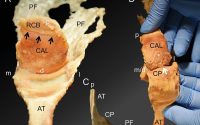Enhancing Hamstring Flexibility with Instrument-Assisted Manual Therapy
Hamstring injuries are a significant concern in sports, particularly in soccer, where they are among the most common injuries. Preventive measures, including strength training and interventions targeting myofascial chains, are critical to reducing injury prevalence. Instrument-assisted manual therapy (IAMT) is gaining attention as a promising approach to improving movement and reducing injury risk by addressing the functionality of myofascial structures.
A study led by scientists in Germany publsihed in Cureus journal evaluates the long-term effects of repetitive IAMT sessions targeting the lumbar back on the functional and structural properties of the dorsal myofascial chain. It focused on improving hamstring flexibility and assessing structural adaptations, such as tissue mobility and shear motion , through ultrasound imaging in a sample of healthy female soccer players.
Methods
Eighteen female soccer players aged 15–35 participated in a randomized, placebo-controlled, and blinded pilot study. Over five weeks, the intervention group (IG) underwent nine standardized IAMT sessions targeting the lumbar back, while the placebo group (PG) received pressureless treatments. Ultrasound imaging assessed structural changes, and flexibility tests measured functional improvements in the hamstrings and spine.
Key Findings
- Improved Hamstring Flexibility:
- The IG exhibited sustained improvements in hamstring flexibility, particularly after nine IAMT sessions. Passive straight leg raise (PSLR) tests showed a significant increase in range of motion (ROM) compared to the placebo group.
- Structural Adaptations:
- Despite functional improvements, ultrasound analysis did not reveal consistent structural changes in tissue mobility or shear motion across the thoracolumbar fascia and erector spinae muscle layers.
- Localized Effects and Hypotheses:
- Functional enhancements were hypothesized to result from localized tissue relaxation and reduced tension due to mechanical stimulation during IAMT. These effects may influence viscosity, hyperemia, and microcirculation.
- Unexpected Observations:
- Active thoracic spine flexibility decreased temporarily in the treatment group but returned to baseline levels by the final measurement. The cause remains unclear and warrants further investigation.
Discussion
The study supports the potential of repetitive IAMT to enhance hamstring flexibility, a critical factor in injury prevention for athletes. However, the lack of observed structural adaptations suggests that IAMT’s effects might be more functional or sensory-driven rather than structural. Previous studies have highlighted short-term benefits of IAMT, but this study demonstrates sustained functional improvements over several weeks.
Strengths and Limitations
This pilot study’s randomized and blinded design ensures robust methodology. However, the small sample size and the focus on female athletes limit the generalizability of the findings. Future research should include larger cohorts, male athletes, and populations with preexisting conditions to validate and expand upon these results.
Conclusions
Repetitive IAMT targeting the lumbar back improves hamstring flexibility in female soccer players over several weeks without significant structural changes detected via ultrasound. The mechanisms underlying these effects remain unclear but may involve mechanical, sensory, and metabolic factors. Future studies should investigate these mechanisms in larger and more diverse populations, including those with recurrent hamstring injuries, to explore IAMT’s potential in injury prevention.


